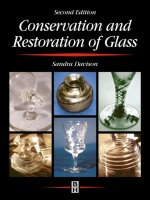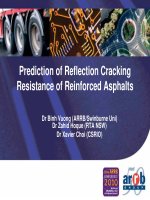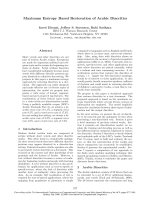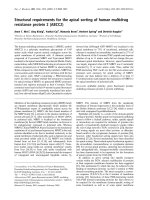Restoration of machine-components wear resistance
Bạn đang xem bản rút gọn của tài liệu. Xem và tải ngay bản đầy đủ của tài liệu tại đây (672.36 KB, 7 trang )
<span class='text_page_counter'>(1)</span><div class='page_container' data-page=1>
VNU Journal of Science, Mathematics - Physics 27 (2011)29-35
Restoration
of
machine-components wear
resistance
V.P. Ivanov, A.P. Kastriuk
Polotsk Stute University, Republic of Belarus
Received 7 December 2010
Abstract. The research relevance is conditioned by the fact that wearing of friction surfaces is
determines their limiting state. The content of the process of components wear resistance reduction
due to the choice of material composition for restoring coatings, the subsequent mechanical and
thermal treatment.
Key words: restoration, wear, wear resistance, coatings, treatment.
1.
The necessity of properfy reductionComponent wear is the result wearing process. The main share
of
components (80-90%)in
theconjunction with other components reaches limiting state due to wearing. As a result of this process
material destruction
and
separationfrom the
surfaceof
the
solid body and
(or)
deformationaccumulation at friction take place. Wear is &taracteized by velocity and intensity. The mentionod
effects leads to gradual change
in
dimensions and (or) shape of components.A
part of wear-resistantlayers
of
componentsis
lost,
andin
conjunctionsof
wearing components closing dimensions(allowances) are changed.
Components
life
accordingto
static capacity as a rule exceedstheir
capacity according to wearresistance and cyclic strength.
At
that, worn components weight to a little degree (I-3%) differs fromnew components weight. Such
a
condition presupposes the useof
components remaininglife
bymeans of restoration of their dimensions and properties to the values specified in technical documents.
Typical varieties
of
components wear are abrasive(by
solid particles gettingin
contact zone),adhesive, oxidizing, fatigue and fretting. Components running together are part
of
a mechanism.At
their restoration it is reasonable to ensure wear resistance and working life equal to the working life
of
the aggregate where the components
work.
Strengtheningof
a
componentis
supposedto
ensuremultiple increase
of
its
workinglife
as compared to a new component, whichis
a technically andeconomically diffi cult task.
2.
The content of wear resistance restorationFor surface wear resistance restoration such methods as coating, cutting, thermal teatment and
surface plastic deformation are applied. The objective of wear resistance restoration includes selection
of coating material, application technique, type and mode of thermal, thermochemical, and mechanical
keatment. These procedures ensure obtaining of required factors:
-
chemical, phase and structrnal composition of coating material;-
hardness ofcoated surface:</div>
<span class='text_page_counter'>(2)</span><div class='page_container' data-page=2>
30
V.P. Ivqnov, A.P. Kastriuk/
WU Journal of Science, Mathematics - Physics 27 (201 1) 29-35-
values and residual stress sign on working surfaces;-
microrelief and roughness of surface after its treatment.At
selection of coating materialit
should be taken in consideration that wear resistance dependsnot only on coating material properties, but also to a significant degree on operative conditions of a
component. Operative conditions are so diversified that there are no universal wear resistant material.
A coating resistant to wear in some conditions may rapidly fail in other conditions.
Continuous ivork of mating components requires material compatibility. By compatibility we shall
understand properties
of
interacting surfaces materialsto
inhibit their
setting at working withoutlubricating stuff or in conditions of continuity violation of oil <sub>layer [1]. </sub>In friction pairs the following
materials are compatible: hard material with soft material (that <sub>fus </sub>the temperature of recrystallisation
lower than the average temperature of the friction surface during operation); and hard material with
hard material (combination of pairs of nitrided, chromized, and hardened steel). Combination of soft
material with soft material as well as pairs of same materials should be avoided.
Wear resistance
of
surface layer is determined by the composition of material and strengtheningphases presence in it.
Coating material composition and structure. According
to
homogeneityof
structure coatingmaterial can be homogeneous (single-phase) or heterogeneous (polyphase). Heterogeneous materials
have higher tribotechnical characteristics. Phases ofheterogentrous coating differ from each other in
their chemical composition and properties and are divided by boundaries. Continuous phase according
to the coating volume or its layer is a mahix (binder), and a phase of separate fragments is reinforcing
or
stren
<sub>). </sub>Coatings with structure of robust steel, nickel or cobalt matrixin
form of asolid
so
particles of solid phasein
form of carbides, borides, nitrites, oxides (Table.P)and intermetallic compounds.
Basic methods for obtaining heterogeneous coatings structure are:
-
making compositions of eutectic and proeutectoid constituents. Such coatings are obtained atsurfacing. They are most widely applied;
-
obtainingof
metastable supersaturatedsolid
solutionsby
meansof
subsequent thermaltreatment. Dispersion hardening (release of highly consistent secondary phases) additionally
strengthens the surfaced coat;
-
retention ofinitial
composite structure of particles in coating due to their incomplete fusion,for example, at spraying. Possibilities for obtaining such coatings with different composition
of strengthening and mahix phases are wider than in coatings obtained by crystallization from
melt;
-
insertion of dispersion strengthening phase to electrochemical coatings at their application.Optimal type of structure for a metallic substrate depends on operative conditions of a material: at
low
specific pressure martensite structureis
preferable, becauseits
hardnessis
closeto
thatof
</div>
<span class='text_page_counter'>(3)</span><div class='page_container' data-page=3>
V.P. Ivanov, A.P. Kastriuk
/
VNU Journal of Science, Mathematics - Physics 27 (2011) 29-35Table l. Physical-mechanical properties of highly consistent phases, applied in materials for components
restoration
31
Phase
Microhardness, hPa oc Densi Modulus of hPaCr7C3
13,7-24,0CryC6
12,3-22,8C4C2
13,5-18,0VC
30Tic
24-32ZtC
28wc'
17,4J2,0CrB2
20,6-21,0vBz
21,0-27,4TiB
32-33w+B
37ZrB
22,5-34,0CrN ll
'/N
15TiN
19,0-20,5ZrN
15Al2o3
20,0-25,4sio2
11,5Cr2O3
29,4I 655
1550
1660
2810
3 150
3420
2720
2200
2400
2980
2800
3040
1500
2180
2950
2950
2050
t720
2300
6,92
6,97
6,68
5,36
4,93
6,57
15,6
5)
5,28
4,45
15,3
6,17
6,1
6,1
5,43
7,1
3,9
2,65
5,21
360
380
280
BnC
270-4'30
460
350_410
6to-120
220
270
455-540
790
220-250
330
267
340-616
400
410
na
I5
405
460
35.H95
2350
3,2The best metallic substrate at impact abrasive, cavitational and mechanochamical wear fracture iE
an admixture of austenite and martensite. Correlation of these components depends on the intensity
of
impact load: the more the impact load, the more the content of austenite in the alloy should be. In such
a case martensite should be low-carbon due to fixation of carbide-forming elements. The quantity and
type of carbides or other solid components also have an effect on the wear resistance of the surface
coating. At the absence of an abrasive in mating pairs wear resistance can be ensured by the presence
of martensite in the structure or martensite with some quantity of carbide fines.
Examples
of
selectionof
phase and chemical compositionof
surfaced coatsfor
componentsworking in different operative conditions are as follows. Rolling of metal on metal: phase composition
of coatings
<sub>- </sub>
90% martensite and l0o/o carbide; chemical composition: C<1, Cr<
15,Ni,
Mo, W.At
manual arc fusing in Coz
it
is possible to apply electrodes PP-AH 103 (200X12M). Friction of metalon metal with lubricating material: phase composition of coatings
<sub>- </sub>
C < 0,5, Cr < 5, Mn < 3,Ni. At
manual
arc
fusingin
Cozit
is
possibleto
apply electrodes3H-60M (70X3 CMT),
wiresPP-25X5@MC
and
PP-AH122(30X5|2CM).
Composition operationin
conditionsof
boundarylubrication (wear type
<sub>- </sub>
contact fatigue): phase composition of coatings<sub>- </sub>
90-100% martensite, 0-10%carbides
or
70-80Yoferrite
and 20-30%o carbides; chemical compositionC
<
0,5, Cr,
Mn
(formartensite maffix), C< 1,2, Cr, Mn. Electrodes HP-70
(30f2XM)
and O3I{-3 (90X4M4BO) and wirePP-AH126 (20X2f2CT).
3.
Values of coatings mechanical propertiesValues of coatings mechanical properties must grow in the direction from the surface to the depth
of metal. This requirement ensures low velocity
of
component wear and is expressed by the ruleof
</div>
<span class='text_page_counter'>(4)</span><div class='page_container' data-page=4>
32 V.P. Ivunov, A.P. Kastriuk
/
WU Journal of Science, Mathematics - Physics 27 (2011) 29-35dc/
dz)
0, H'v-3,where
T
is
breaking shear stress, Pa;z
<sub>-values </sub>of
coordinate directedto
the depthof
materialperpendicular to friction surface, m.
Ifthe
inverse takes place, the generated surface ties are stronger than the depth ones and settingof
the friction surface takes occurs. For instance, soft constituent
of
austenitic steels does not allowobtaining high
qtality
of components working surfaces from such materials.Allows of new generation
<sub>- </sub>
fractal materials with broken long-range order, are highly efficient.Amorphous alloys ropresent
a
specimenof
such materials. They have universal physicochemicalproperties, nevertheless their application
in
engineeringis
limited dueto
the fact that obtainingof
coatings of them requires more system non-equilibrium than
it
is required at ultraspeed cooling. Thefuture of fractal materials is associated with the development of two areas
<sub>- </sub>
development of chemicalcomposition
and
techniquesthat would allow
obtainingof
massive amorphousalloys,
anddevelopment of nano- aird microcrystalline materials.
4.
Impact of material hardness and internal stressThere is no univocal connection between wear resistance and hardness. The intensity of abrasive
wear depends on the correlation of hardness of the material base and the ingrained abrasive material
[3]. This peculiarity, conditionally called the effect of ultra wear resistance, opens new possibilities for
improving components working life. The effecf is that the linear dependence between wear resistance
and hardness
is
broken, and wear resistanceat
some typesof
wearis
dramatically increasedCorrelation of material hardness and abrasive particles with respect to shaft necks subject to abrasive
wear, must be not less that 0,7. The increase
in
surface wear resistance, for instance, is ensured bywelding
of
a steel bandwith
a widthof
0,3-0,5 mm.with
carbon content no more that 0,5% withparticles of hard alloys of BK and TK groups, and of wolframfree alloys of KXT and
IITX
t1,pes withthe size of 0,3-0,5 mm. Sound connection of particles with the steel band ensures heating of the
sub-electrode lotto the temperature
of
1350"C and the pressureof
at least 33 MPa. Wear resistanceof
coatings
is
10to
15 times higher than thatof
hardened steel45
and 2,6 times more than thatof
coatings
of
self-fluxing alloys. Coatings are applied with the helpof
condenser seam machines forcontact welding, for instance
\/nllII-2002
(K-421M) or with the help of special equipment developedby
National Research and Production Association "Remdgtal" operatingon
altemating current.Restored shaft necks are polished with a diamond *heel
AIIfI
300x27x127x5ACB
100/80MBI
on ametallic bond. On samples
with
composite coatings predominately compressive residual stesses arecreated on the surface layer. Fatigue resistance limits of the samples is 8olo lower than that of reference
samples of steel45 with surface hardening to hardness 52 HRC.
An
important componentof
physicochemical stateof
a surface layeris
the value and signof
residual stresses in the surface layer.
It
is necessary to strive for obtaining compressive stressesin
acoating.
The value and the sign of residual stresses in a material depend on the following factors:
</div>
<span class='text_page_counter'>(5)</span><div class='page_container' data-page=5>
V.P. Ivanov, A.P. Kastriuk
/
WU Journal of Science, Mathematics - Physics 27 (2011)29-35
33-
final mechanical treatment modes. For decreasing tension stressesit
is necessaryto
ensureminimal heating
of
a component at final mechanical treatment.In
such a case strengtheningfrom cutting load in the surface layer forms compressive stress in the coating surface layer;
-
Usageof
surface plastic deformation (SPD). Cold workingof
a
surfaceat
SPD ensuresformation
of
compressive stressin
a surface layer. The higher the hardness the higher theeffect of SPD treatment. For example, for a component surface made of steel 45 at running-in
force of 2250 MPa compressive stress of 400-500MPa is achieved in the depth up
to
1.0 mm.5.
Microgeometry offriction
surfaceGeometric state of the coating surface layer is determined by roughness and presence of surface oil
pockets, Coating pores or dimension cavities on the surface can serve as oil pockets or reservoirs.
Wear resistance of coatings can be controlled by changing their porosity. Pores act as reservoirs
for
lubricating material thatis
extruded fromits
volumein
the courseof
wearing and getsin
thefriction zone, contributing
to
restorationof
boundary lubrication. Obtainingof
porous coatings bymeans
of
gas-thermal spraying is the most efficient. Such coatings are also saturatedin
lubricatingmaterials for improvement of wear resistance.
In a number of cases discreet or continuous cavities on a friction surface obtained by knurling can
also serve as
oil
reservoirs.An
example is treatment of piston surfacesof
aluminum alloy runningtogether with the surface of steel or cast-iron cylinder.
An
efficientway
for
increasing wear resistanceof
componentsin
a
frictionpair
is
changingphysicochemical state of a layer due to final afitifriction nonabrasive treatment (FANT). The essenca
of
such treatmentis
that the surfaceof
components frictionis
coatedwith
a fine brass, bronze orcopper layer. The work surface is degreased, and prior to coating deposition it is covered with glycerol
or glycerol-base solution. Coating deposition process is friction rubbing
of
a copper alloy to a steelsurface (Table 2). Rubbing
is
carried out bothby
iron cores and hogs andby
loose spherical andcylindrical rollers. The thickness
of
antifriction layer of brass on the baseof
steel at FANT is 2-3micron, bronze and copper
<sub>- </sub>
l-2
micron. Roughnessof
the original layer must be about Ra 2,5micron. As a rule, FANT slightly reduces the surface roughness.
At
small parameters of the surfaceroughness (Ra 0,63-0,08 micron) FANT does not change their values.
Coatings deposited with FANT ensure positive gradient of mechanical properties (soft fiim covers
hard surface), increase the area
ofreal
contactof
surfaces and reduces friction force, and plasticizes</div>
<span class='text_page_counter'>(6)</span><div class='page_container' data-page=6>
a
;
fl€+
<sub>E </sub>
<sub>= </sub>
B
a
e
EFEHigEFggEigg,Fgu
N
?
(.1
s
9E
E
-XH 5 o
c{ "q3 ..ii co cn o. 6t
\9 <sub>-14 S! </sub> \O= \O \O ; 5 3
H ES.6
tr;
<sub>H tr H h </sub>
tr
a *i;r
qqv
q 6 r F ag
H sEqil
HE?
E E E a
Es
m f\m,:m A6.F A m ; r\ <sub>vqq</sub> A;
'fi+
<sub>si-i {'.- </sub>
k€E
EE
€H
€?'F=
iS f?-
E6iE
EE
fi:EB
f
E
E
Eigses
Fsees
n
nn
-$
-$ IqI$::
::.a=.a B
gg
o o
<sub>=HHUPiE VEO'HO o o(,</sub>
€
F> fi:c
h
€: 'E:€
r.
A.
F S1l iEl
.d
E.
d$
B
Eilg
ggE
s
E
s€
Bs
5
frHrilC*€s:sg
\ 6 E
<sub>TEh. </sub>
<sub>EgE 6:i </sub>
hE
8 Y, t, Aax 6Ea
q'E#
5A
ao
c.t:fl
OOF-O
@r6lf-coN<sub>tl</sub>
NN i
$**
co crr eo I
6l
e{N$
?oo?c{?h
d C\NNO (\H <sub>ol </sub> d H(\
c.l \o c\
YfY<sub>ttl</sub>
'.)ooo
o
o
\o \a o
$o
H(\.t(\{i (\H r) O O (\t HcO
o.oR
ooo
o
a.t
\o-OOt\ F- H I
llltroo
oooo
oo
o
6t
cooo\o<f,t-- r-t @ r. c.l
9
O
x
l(+{
lo
lk
lO @
l-O a)
ItrJ1
lz6
I
t^
lc)
t,!)
tEi
tq
El-*
I
t*
t9
lo
l* O
t9
vlo ()
.19
9Httr
(ii
.^EI6;E
dl
HI
btu
I
Fli 5? cu
el5
rs
(t
.F
(.)
(.;)
O
F
!Y
(.)
'i
(,)
€
q
O
!.1
o\
N
+F
.l
<sub>x</sub>
7
sl!
N(H
NO
6q.
NE
sE
<sub>\x</sub>
6d
.YO
s8
E€
:ro
-d
;(g
.93
th
\\H
va)
'Ez
<sub>s.x</sub>
\g
FJ()
\-a(l
\o
-*?
'S o)
t6
6d.*c
\;d
-H
\
\
e.i(.)
:t-s
</div>
<span class='text_page_counter'>(7)</span><div class='page_container' data-page=7>
V.P. Ivanov, A.P. Kastriuk
/
WU Journal of Science, Mathernatics - Physics 27 (2011)29-35
356.
ConclusionConditions ensuring standard wear resistance
of
restored components surfaces are come toobtaining heterogeneous structure of coating material with presence of hard fine-dispersed inclusions
mainly carbides,and nitrates. Conditions for obtaining such structure are presented. Positive gradient
rule for mechanical properties
of
coating material to thedepth of its
surface layers are ensured atusage of final antifriction nonabrasive treatment.
References
[]
D.N. Garkounov, Tribotechnics: Textbookfor higher educational establishments.lD.N. Garkounov. 2nd edition, amendedand supplemented. M. Machine-building, 1989, 328 p.
[2] P.N. Bogdanovich, Friction and wear in machines: textbook / P.N. Bogdanovich, V.Y. Proushak.
<sub>- </sub>
Minsk.: Higherschool, 1999,374 p.
</div>
<!--links-->









